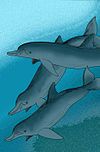User:Abyssal/Portal:Neogene
IntroductionSelected article on the Neogene world and its legacies
The geology of Scotland is unusually varied for a country of its size, with a large number of differing geological features. There are three main geographical sub-divisions: the Highlands and Islands is a diverse area which lies to the north and west of the Highland Boundary Fault; the Central Lowlands is a rift valley mainly comprising Paleozoic formations; and the Southern Uplands, which lie south of the Southern Uplands Fault, are largely composed of Silurian deposits.
The existing bedrock includes very ancient Archean gneiss, metamorphic beds interspersed with granite intrusions created during the Caledonian mountain building period (the Caledonian orogeny), commercially important coal, oil and iron bearing carboniferous deposits and the remains of substantial Paleogene volcanoes. During their formation, tectonic movements created climatic conditions ranging from polar to desert to tropical and a resultant diversity of fossil remains. Scotland has also had a role to play in many significant discoveries such as plate tectonics and the development of theories about the formation of rocks and was the home of important figures in the development of the science including James Hutton, (the "father of modern geology") Hugh Miller and Archibald Geikie. Various locations such as 'Hutton's Unconformity' at Siccar Point in Berwickshire and the Moine Thrust in the north west were also important in the development of geological science. (see more...) Did you know?
Need help?Do you have a question about Abyssal/Portal:Neogene that you can't find the answer to? Consider asking it at the Wikipedia reference desk. Selected image
Selected article on the Neogene in human science, culture and economics
On the Origin of Species, published in 1859, is a work of scientific literature by Charles Darwin which is considered to be the foundation of evolutionary biology. Darwin's book introduced the scientific theory that populations evolve over the course of generations through a process of natural selection. It presented a body of evidence that the diversity of life arose by common descent through a branching pattern of evolution. Darwin included evidence that he had gathered on the Beagle expedition in the 1830s and his subsequent research findings. Ideas about the transmutation of species were controversial as they conflicted with beliefs that species were unchanging parts of a designed hierarchy and that humans were unique and unlike animals.
The book was written for non-specialist readers and attracted widespread interest upon its publication. As Darwin was an eminent scientist, his findings were taken seriously and the evidence he presented generated scientific, philosophical, and religious discussion. Within two decades there was widespread scientific agreement that evolution, with a branching pattern of common descent, had occurred, but scientists were slow to give natural selection the significance that Darwin thought appropriate. During the "eclipse of Darwinism" from the 1880s to the 1930s, various other mechanisms of evolution were given more credit. With the development of the modern evolutionary synthesis in the 1930s and 1940s, Darwin's concept of evolutionary adaptation through natural selection became central to modern evolutionary theory, and it has now become the unifying concept of the life sciences. (see more...) TopicsGeochronology - Neogene (Miocene - Pliocene) Neogene landmasses - Major Neogene events - Neogene biota appearances - Fossil sites - Stratigraphic units - History - History of paleontology - Timeline of paleontology Researchers - Culture - Treatise on Invertebrate Paleontology - Vertebrate Paleontology SubcategoriesQuality ContentFeatured Neogene articles - None yet Good Neogene articles - Nonet yet Things you can doWikiProjects
Related contentAssociated WikimediaThe following Wikimedia Foundation sister projects provide more on this subject:
|























